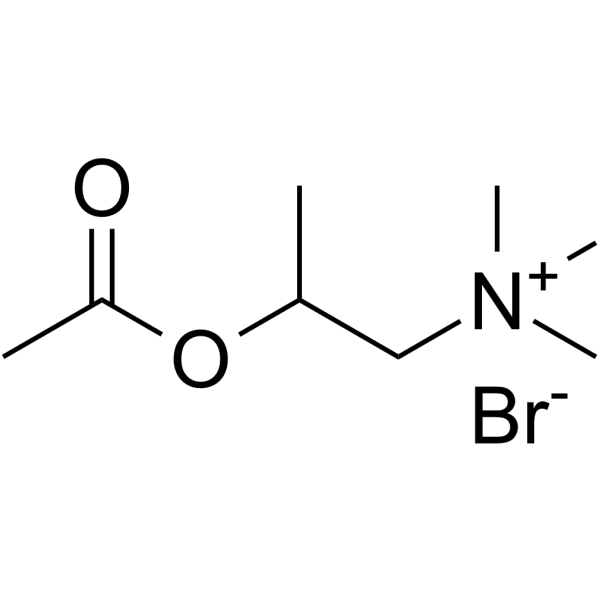333-31-3
| Name | methacholine bromide |
|---|---|
| Synonyms |
2-Acetoxy-N,N,N-trimethyl-1-propanaminium bromide
METHYLCHOLINE BROMIDE UNII:M73AI9718D metacholine ACETYL-B-METHYLCHOLINE BROMIDE Acetyl-β-methylcholine bromide Acetyl-beta-methylcholine bromide O-Acetyl-β-methylcholine Bromide MECHOLYL BROMIDE ACETYL SS-METHYLCHOLINE BROMIDE MFCD00011816 1-Propanaminium, 2-(acetyloxy)-N,N,N-trimethyl-, bromide (1:1) Methacholine 2-acetoxy-n,n,n-trimethylpropan-1-aminium bromide EINECS 206-372-2 1-Propanaminium, 2-(acetyloxy)-N,N,N-trimethyl-, bromide |
| Description | Methacholine (Acetyl-β-methylcholine) bromide is a potent muscarinic-3 (M3) agonist. Methacholine bromide acts directly on acetylcholine receptors on smooth muscle causing bronchoconstriction and airway narrowing. Methacholine bromide shows a high sensitivity to identify bronchial hyperresponsiveness (BHR). Methacholine bromide can be used to measure airway hyperresponsiveness (AHR) as a diagnostic aid in the assessment of individuals with asthma-like symptoms and normal resting expiratory flow rates[1][2][3][4]. |
|---|---|
| Related Catalog | |
| In Vivo | Methacholine bromide (0.5 µg/kg plus 5 µg/kg/min for 30 min) induces bronchoconstriction in dogs[4]. Methacholine bromide (0.5 mg/kg; i.v.) induces bronchoconstriction was inhibited by bradykinin (4-40 µg/kg; i.v.) in a a dose-dependent manner in mouse[5]. Animal Model: 9-week female BALB/c mice[6] Dosage: 0.03, 0.1, 0.3, 1 mg/kg Administration: I.v Result: Induced severe bronchoconstriction. |
| References |
[3]. Cockcroft DW. Methacholine challenge methods. Chest. 2008;134(4):678-680. |
| Melting Point | 147-149ºC(lit.) |
|---|---|
| Molecular Formula | C8H18BrNO2 |
| Molecular Weight | 240.138 |
| Exact Mass | 239.052078 |
| PSA | 26.30000 |
| Hazard Codes | Xi: Irritant; |
|---|---|
| Risk Phrases | 36/37/38 |
| Safety Phrases | 26-36 |
| HS Code | 2923900090 |
|
~% 
333-31-3 |
| Literature: Journal of Pharmacology and Experimental Therapeutics, , vol. 51, p. 258 Chem. Zentralbl., , vol. 106, # I p. 436 |
|
~% 
333-31-3 |
| Literature: US2192204 , ; |
| HS Code | 2923900090 |
|---|---|
| Summary | 2923900090 other quaternary ammonium salts and hydroxides。Supervision conditions:None。VAT:17.0%。Tax rebate rate:9.0%。MFN tariff:6.5%。General tariff:30.0% |




